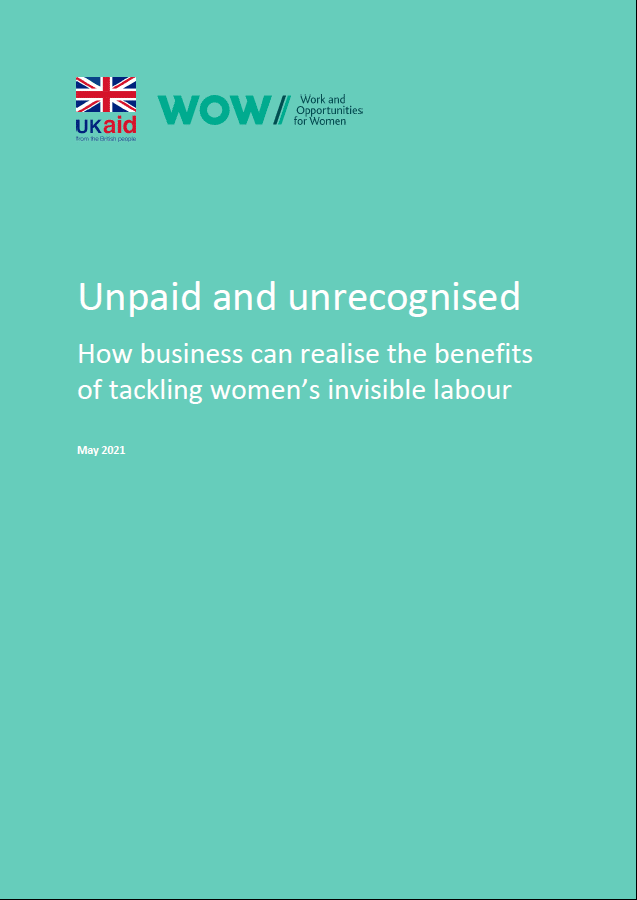At a time of global economic downturn, when record numbers of women have lost their jobs and with more women than ever having to juggle paid work and unpaid care responsibilities, taking action to support these women and recognise their work has never been more urgent.
The excessive amount and unequal distribution of this invisible labour is a major barrier to women’s full and equal participation in the paid workforce that has been ignored for too long. Covid-19 has intensified this, with ever more women using their time to care for, educate and feed families and communities. Indeed, during the pandemic, in most countries women are spending over 30 hours per week solely on childcare – almost equivalent to an additional full-time job. And younger children, disproportionately girls, may be helping them with domestic responsibilities which are often seen as the domain of women and girls.
Invisible labour includes work done by individuals that both directly and indirectly supports global value chains but is unrecognised and unremunerated. The majority of businesses have not recognised just how much they rely on this invisible work to keep their supply chains from collapsing. Family workers on farms may not have their labour valued at all, causing them to survive on poverty wages and pushing the viability of their business to a knife edge, where any shocks could cause their enterprises to collapse. Female and male workers may get family members and children to support them during busy periods or if piece rates are set incorrectly, posing not only child labour risks but a risk of modern slavery, should payment not be distributed amongst workers or if exploitative labour practices are in place. Highly skilled and productive women workers may leave the workforce all together after starting a family, look after older relatives or those with disabilities, leaving companies with skills gaps and significant retraining costs. Women with caring responsibilities who remain in the paid workforce may experience high levels of physical and mental strain from excessive unpaid care commitments, affecting their health and limiting their paid workplace productivity.
is unrecognised and unremunerated. The majority of businesses have not recognised just how much they rely on this invisible work to keep their supply chains from collapsing. Family workers on farms may not have their labour valued at all, causing them to survive on poverty wages and pushing the viability of their business to a knife edge, where any shocks could cause their enterprises to collapse. Female and male workers may get family members and children to support them during busy periods or if piece rates are set incorrectly, posing not only child labour risks but a risk of modern slavery, should payment not be distributed amongst workers or if exploitative labour practices are in place. Highly skilled and productive women workers may leave the workforce all together after starting a family, look after older relatives or those with disabilities, leaving companies with skills gaps and significant retraining costs. Women with caring responsibilities who remain in the paid workforce may experience high levels of physical and mental strain from excessive unpaid care commitments, affecting their health and limiting their paid workplace productivity.
Now is the time to assess how this invisible labour can be more effectively addressed – by families, communities, national governments and business. After all, everyone stands to gain by accelerating progress towards a gender equitable world. In this world, women will be able to claim voice and agency in their lives, be able to take advantage of economic opportunities and improve their health and wellbeing. Companies have an opportunity to be authentic leaders on a complex shared challenge, create meaningful change for women and advance progress towards a gender-just economy.
Failure to seize this opportunity will result in less resilient supply chains and increased uncertainty in the face of future shocks – be they climate, automation, or further pandemics – all of which will arguably increase the amounts of invisible labour undertaken by women.
The Body Shop and Primark have worked with the Work and Opportunities for Women (WOW) Programme to improve understanding of women’s invisible labour. At Primark we found that some women working in its suppliers’ factories in Bangladesh are essentially working a ‘double day’ when unpaid labour related to household and family care duties are taken into account. At The Body Shop we have learned how to better assess and address invisible labour via production management and costings. We will continue pushing to improve our companies’ approaches to invisible labour, but systemic change is not possible on our own, company by company.
Collaboration within and across our industries will accelerate change benefitting women all over the world. We urge our fellow business leaders to take action on invisible labour by using this guide to start conversations on this important topic and bring the issue into the spotlight. The guide includes practical suggestions of how to tackle these issues, if you are sourcing directly from women’s cooperatives or working with suppliers. Whether it’s lobbying for improved social protection programmes, informing workers of their rights to maternity and paternity leave or establishing childcare facilities, there are plenty of ideas to get you started.
Together, we can create a more gender equal world.










